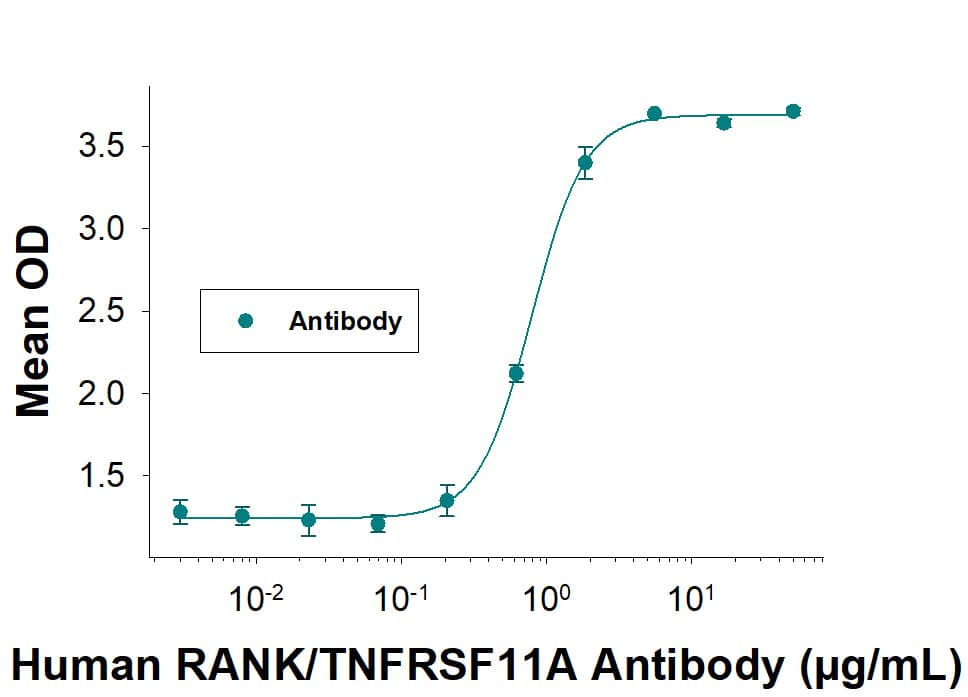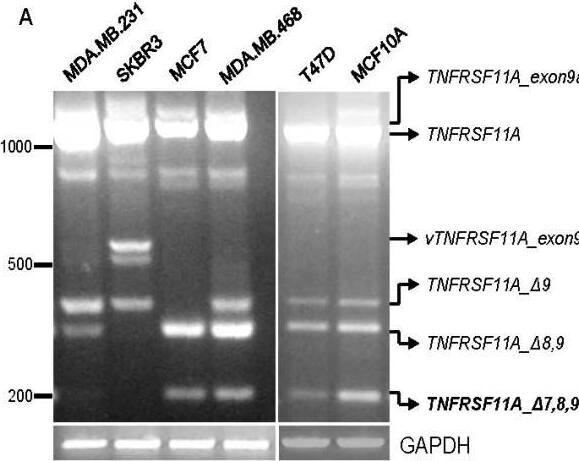Human RANK/TNFRSF11A Antibody
R&D Systems, part of Bio-Techne | Catalog # AF683


Key Product Details
Species Reactivity
Validated:
Cited:
Applications
Validated:
Cited:
Label
Antibody Source
Product Specifications
Immunogen
Gln29-Gly213
Accession # Q9Y6Q6
Specificity
Clonality
Host
Isotype
Endotoxin Level
Scientific Data Images for Human RANK/TNFRSF11A Antibody
Human RANK/TNFRSF11A Antibody Agonist Activity
Human RANK/TNFRSF11A Antibody (Catalog # AF683) induces osteoclast differentiation of RAW 264.7 mouse monocyte/macrophage cells in the presence of recombinant mouse M-CSF (416ML). The ED50 for this effect is typically 0.0750 – 1.50 μg/mL.Detection of RANK/TNFRSF11A by Western Blot
Expression of mRNA encoding tumor necrosis factor receptor superfamily, member 11a (TNFRSF11A, wild type receptor activator of NF-kB, wt RANK), TNFRSF11A_ delta9 (RANK-a), TNFRSF11A_ delta8,9 (RANK-b) and TNFRSF11A_ delta7,8,9 (RANK-c) in breast cancer cell lines and breast cancer samples. A. Agarose gel electrophoresis (2%) of PCR products using primers P1 and P2 depicting TNFRSF11A and the identified alternative splice variants in MDA-MB-231, SKBR3, MCF7, MDA-MB-468, T47D and MCF10A breast cancer cell lines. vTNFRSF11A_exon9a was observed only in SKBR3 and after cloning and sequencing was identified as a TNFRSF11A variant encompassing exons 6, 7, 8, 9a and 10. Splice variant TNFRSF11A_ delta7,8,9 is in bold. B. TNFRSF11A_ delta7,8,9 (RANK-c) relative mRNA expression levels in a panel of breast cancer cell lines and the non-tumorigenic epithelial cell line MCF10A; values obtained for MCF10A were set to 100. C. Relative mRNA expression levels of variant TNFRSF11A_ delta7,8,9 (RANK-c) in a panel of formaldehyde-fixed paraffin embedded (FFPE) invasive ductal breast carcinoma samples analyzed against tumor histological grade and proliferation index Ki-67, respectively. D. Relative mRNA expression levels of TNFRSF11A (wt RANK) in the same panel of invasive ductal breast carcinoma samples plotted against tumor histological grade. Image collected and cropped by CiteAb from the following open publication (https://pubmed.ncbi.nlm.nih.gov/22824341), licensed under a CC-BY license. Not internally tested by R&D Systems.Detection of Human RANK/TNFRSF11A by Western Blot
Induction of the expression of RANK-L, OPG, and RANK by normal human blood neutrophils incubated in the presence of synovial fluid (SF) from patients with rheumatoid arthritis (RA) or patients with osteoarthritis (OA). (a) Surface expression of RANK-L by normal blood neutrophils incubated in SF from patients with RA (RA-SF) or OA (OA-SF) for 2 days. Flow cytometry was performed after incubation of neutrophils with a goat anti-human RANK-L antibody followed by a fluorescein isothiocyanate (FITC)-conjugated anti-goat F(ab')2 antibody. Control isotype antibody was a normal goat immunoglobulin G (IgG). Results shown are representative of three RA-SF and nine OA-SF. (b) Expression of mRNA for OPG and RANK by normal blood neutrophils incubated for 2 days in SF from four patients with RA and two patients with OA. Total RNA was isolated from freshly isolated normal blood neutrophils (D0) and from neutrophils of the same healthy donors after 2 days of incubation in SF (RA-1 to -4, OA-1, -2). RNA was then analyzed by reverse transcriptase-polymerase chain reaction. Results shown are representative of two different healthy donors. (c) Surface expression of RANK by normal blood neutrophils incubated in SF from patients with RA (RA-SF) or OA (OA-SF) for 3 days. Flow cytometry was performed after cellular fixation, permeabilization, and staining with a mouse monoclonal anti-human RANK antibody followed by a FITC-conjugated anti-mouse F(ab')2 antibody. Control isotype antibody was a non-specific mouse IgG. Results shown are representative of neutrophils from two different healthy subjects incubated in three different RA-SF and two OA-SF. OPG, osteoprotegerin; RANK, receptor activator of nuclear factor-kappa-B; RANK-L, ligand of receptor activator of nuclear factor-kappa-B. Image collected and cropped by CiteAb from the following open publication (https://pubmed.ncbi.nlm.nih.gov/17341304), licensed under a CC-BY license. Not internally tested by R&D Systems.Applications for Human RANK/TNFRSF11A Antibody
Agonist Activity
Western Blot
Sample: Recombinant Human RANK/TNFRSF11A Fc Chimera (Catalog # 683-RK)
Formulation, Preparation, and Storage
Purification
Reconstitution
Formulation
*Small pack size (-SP) is supplied either lyophilized or as a 0.2 µm filtered solution in PBS.
Shipping
Stability & Storage
- 12 months from date of receipt, -20 to -70 °C as supplied.
- 1 month, 2 to 8 °C under sterile conditions after reconstitution.
- 6 months, -20 to -70 °C under sterile conditions after reconstitution.
Background: RANK/TNFRSF11A
RANK (receptor activator of NF-kappa B, also known as TRANCE receptor, osteoclast differentiation factor receptor [ODFR]) and TNFRSF11A is a member of the tumor necrosis factor receptor family. The full length human RANK cDNA encodes a type I transmembrane protein of 616 amino acids with a predicted 184 amino acid extracellular domain and a 383 amino acid cytoplasmic domain. The extracellular domain contains two potential N-linked glycosylation sites. RANK shares significant amino acid homology with other members of the TNF R family in its extracellular four cysteine-rich repeats. Human and murine RANK share 81% amino acid identity in their extracellular domains. RANK is widely expressed with highest levels in skeletal muscle, thymus, liver, colon, small intestine and adrenal gland. RANK is expressed in dendritic cells. In activated human peripheral blood T lymphocytes, RANK expression is induced by IL-4 and TGF-beta. Multiple tumor necrosis factor receptor-associated factors (TRAFs) are involved in the signaling of RANK. TRANCE (TNF-related activation-induced cytokines, also known as RANK ligand [RANKL], osteoprotegerin ligand [OPGL], and osteoclast differentiation factor [ODF]) is the ligand for RANK. The biological functions mediated through RANK include activation of NF-kappa B and c-jun N-terminal kinase, enhancement of T cell growth and dendritic cell function, induction of osteoclastogenesis, and lymph node organogenesis. Soluble RANK is able to block TRANCE induced biological activity.
References
- Anderson, D.M. et al. (1997) Nature 390:175.
- Nakagawa, N. et al. (1998) Biochem. Biophys. Res. Commun. 245:382.
Long Name
Alternate Names
Gene Symbol
UniProt
Additional RANK/TNFRSF11A Products
Product Documents for Human RANK/TNFRSF11A Antibody
Product Specific Notices for Human RANK/TNFRSF11A Antibody
For research use only

